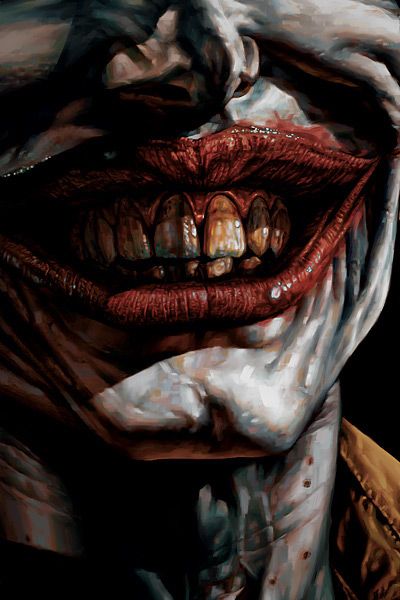I like the idea of DC producing original graphic novels using elements of their superhero universe. And at $19.99 for a 128-page hardcover by Brian Azzarello and Lee Bermejo, "Joker" hits just the right price point. In theory, an original graphic novel would give writers and artists more freedom to experiment with form and content, and they certainly wouldn't be bound by any expectations to work in discrete 22-page chunks. Azzarello and Bermejo take advantage of that freedom here, but they seem bound by a far more powerful master here: the ghost of Heath Ledger.
Whether it's true or not, "Joker" feels like it was commissioned specifically as a tie-in to the biggest movie of the year. It's not an adaptation of "The Dark Knight," nor is it exactly a spin-off, but it's informed by that movie, even though -- given the lead time on projects like this -- it must have been written long before Azzarello saw the film in theaters. Yet there's a clear Heath Ledger influence here, and it seems as if Azzarello and Bermejo were working off early teaser trailer indications of the film, and then extrapolating from there. Their version of the Joker isn't the same as what we see in the movie, but it's certainly on the Ledger end of the spectrum. And I think that's a respectable choice, considering that Ledger has defined the character for our generation.
And Azzarello, notoriously uninterested in superheroes, brings in the street-level crime elements needed to make that kind of Joker work best. "Joker" isn't hard-boiled in the Mickey Spillane-by-way-of-Frank Miller way that we saw in his "Batman: Broken City" tale a few years back. Instead, it's like a Michael Mann film on paper, exploring the Joker's struggle to regain control of the Gotham underworld. Azzarello writes to Bermejo's strengths here, giving him a sleek but sullied world to illustrate, characters who slice a path through Gotham City like so many dirty razors.
Killer Croc appears, as does Two-Face, the Riddler, and the Penguin, all of whom presented in ways that differ from their in-continuity counterparts. Azzarello and Bermejo seem to be auditioning their interpretations for future movie use, suggesting that Killer Croc might work as a steroidal black gang leader who lives in a meat locker, or the Riddler could be a tatted-up cripple with a knowing smile. These versions of the characters are interesting only in the way the Joker interacts with them, but it's important that Azzarello and Bermejo keep them all tonally consistent with the kind of semi-real, movie version of Gotham presented here. And he pulls it off, with his own cynical edge.
There's plenty to love about "Joker," including the truly disturbing mania of the Joker himself. This isn't a Batman story about the Joker, and, even more so than "The Killing Joker," this is an exploration of the Joker as a character. Batman isn't completely absent, but, for much of this graphic novel, it's as if Gotham City doesn't even have a protector. It's all crime and bloodshed and horror.
The major misstep of "Joker," and it is a big one, is the use of a new character, Jonny Frost, as the narrator. Frost is our window into this criminal corridor, and as he drives the Joker around and comments upon the action, we watch and learn. But Azzarello's mistake here is that he makes Frost too prominent to be ignored but not interesting enough to matter. Frost should be a powerful force within the story, or he should be a passive narrator, but Azzarello gives us something in the middle: a character whose subplot intersects with the Joker's rampage on Gotham, but yet a character who feels insubstantial. Mostly, the focus on Frost just turns attention away from what matters, and what matters is the Joker.
As a spiritual sequel to this summer's movie, or as, perhaps, a deranged counter-argument, "Joker" works quite well. It's a beautifully ugly graphic novel, suitably so. But it's certainly not perfect, although I'm sure the Joker wouldn't have it any other way.

